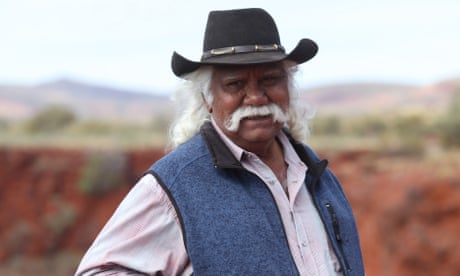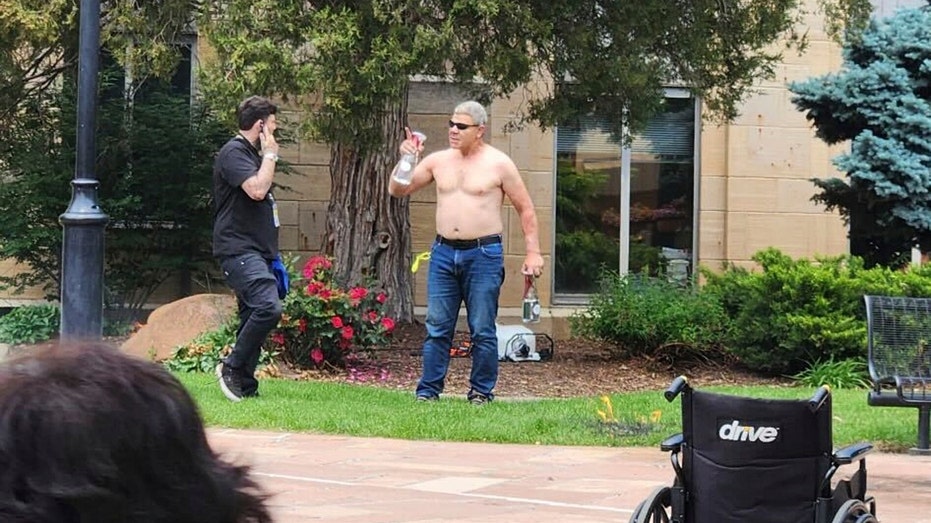- by foxnews
- 04 Jun 2025
‘I’m so angry, I’m wild’: the never-ending wait to clean up asbestos town Wittenoom
‘I’m so angry, I’m wild’: the never-ending wait to clean up asbestos town Wittenoom
- by theguardian
- 30 May 2022
- in news

Deep in the heart of Western Australia's outback, Maitland Parker is fighting the biggest battle of his life, and it is not because he is dying of cancer.
The Banjima elder's mob have lived around the area now known as Wittenoom for tens of thousands of years, but he can no longer go there. The eerily striking Pilbara town - at the foot of a deep gorge, 15 hours' drive north-east of Perth - is blanketed in the deadliest type of asbestos, crocidolite. This has earned it the unwanted accolade of being the "largest contaminated site in the southern hemisphere".
Simply drawing breath here has killed thousands, many years after exposure.
Just shy of 70, Parker has lived his whole life in this rugged, ancient landscape. The white-haired, park ranger may be a gentleman, but he doesn't mince his words.
"My people were never consulted about the asbestos mine's existence in the first place and now no one will talk to us about cleanup either," Parker says.
While asbestos mining ended in Wittenoom in 1966, it is still unclear who is responsible for removing 3m tonnes of carcinogenic mining waste, piled at least 40m high into the nearby gorges like amalgam in a filled tooth.
Since 1978, consecutive state governments have commissioned inquiries, ordered reports, and formed committees to examine the problem. All have failed to remediate the land. And the contamination is spreading.
Two months ago, on 24 March, the WA parliament passed the Wittenoom Closure Bill. The bill's passage put "an end to a dark period in the state's history", WA lands minister John Carey said at the time.
It gives officials the power to forcibly buy and demolish the town's 14 remaining buildings. Government can finally expel the steadfast few remaining residents and stop the 60 tourists a week that risked their lives to visit the "ghost town".
But the bill does not tackle cleaning up the Wittenoom Asbestos Management Area - a contaminated site that spans 46,000ha, an area half as big as Singapore.
For Parker, without a cleanup, there is no closure. People are still being exposed to the microscopic shards of asbestos fibres that cause mesothelioma - a highly aggressive cancer.
As a Traditional Owner, he wants the site cleaned up so his people can uphold their cultural obligation of tending to the land. It is as much a spiritual connection as it is physical.
"I'm so angry, I'm wild. They imposed a death sentence on anyone trying to connect with country in Wittenoom gorge," Parker says.
"My people will still go there, because they have to, we have a purpose that we keep the country alive, and the country will help us and look after us.
"The only thing the government has done is clean up the houses, but they should put their hand in their pocket and start doing something about the rest of it."
Parker was diagnosed with mesothelioma in 2016. Most patients don't survive more than two years. The fight for justice keeps him alive, he says.
It took him and others 15 years to achieve native title over Banjima country, where now asbestos flows in the rivers and streams and the fibres blow in the wind, churned up by passing vehicles and storms.
In January this year, the local Ashburton shire council CEO, Kenn Donohoe, warned an Environment and Public Affairs subcommittee that Wittenoom asbestos spreads in heavy rain on to the public Munjina/Manutarra Road, which is used by tourists, miners and pastoralists.
"The asbestos fibres are not being contained at Wittenoom and are spreading," the letter read. He also wrote to the fire services about a risk to firefighters sent into the area and asbestos spreading across district roads, including one of "regional importance".
Parker is calling for the former asbestos mining companies, now worth billions, to be held responsible - at least in part - for removing the washed-out mountains of toxic waste.
A parliamentary inquiry in 1994 was unequivocal that the buck stops with the mining companies. "The committee considers that the companies responsible should clean up the widespread contamination that they caused in the gorges and recommends that the state government take instant and determined action to ensure that this occurs," it stated.
However, a 1988 letter from then mines minister Jeff Carr to WA's North Province MLC Tom Stephens suggested that responsibility for the tailings dump was the state government's "since the mining company relinquished its mining lease in 1979 and the land reverted back to the crown."
That same letter estimates remedial work of the tailings to cost in excess of $20m. Today, the former WA Greens MP Robin Chapple, who worked in Wittenoom and retired from parliament in 2020 after being diagnosed with asbestosis, estimates the sum to be about $600m. Some other estimates put the figure at around $100m.
Chapple claims the government has costed cleaning up Wittenoom and the gorges, but a freedom of information request for the information was denied because of commercial confidentially. Guardian Australia requested the cleanup costing document, but it was not provided nor was its existence confirmed.
After struggling in vain for almost 60 years to get governments in Australia to clean up the contamination, the Asbestos Disease Society of Australia (ADSA) is taking its fight to the rest of the world. It is fundraising for a multimillion-dollar international competition to clean up Wittenoom.
"We want to save lives, so we are reaching out to the international community for help, because the problem is not being fixed at home," ADSA's CEO, Melita Markey, whose father was employed at the mine, says.
"We want to see if the world's great minds can clean up the contamination."
Chapple says that the government has the mechanism and the money to clean up the issue. He says the asbestos waste piles should be liquefied and poured into the old mine shafts, before being cemented closed.
Markey says she has seen government engineering drawings that show a concrete wall, built at the base of the gorges to dam the creek, could stop the tailings from spreading.
Carey did not answer questions about who would foot any Wittenoom cleanup bill or what cleanup would look like. He pointed instead to the re-establishment of the Wittenoom Steering Committee.
WA earned $11.3b in iron ore mining royalties in 2020-21 and the WA budget handed down this month had a $5.7b surplus. No funds were allocated to the Wittenoom matter.
Carey said the committee "will assess ongoing management options" but admitted the area may never be made safe for people to visit, even with significant remediation efforts.
"We do need to be realistic about what can be achieved," he said.
Lang Hancock and Peter Wright may be synonymous with iron ore, but the mining entrepreneurs started out with blue asbestos from Wittenoom. In 1939, with the world on the precipice of war, the entrepreneurs were using explosives, hand tools and a mill to mine and export the fire and heat-resistant mineral to European armies.
Four years later, Colonial Sugar Refinery Company (CSR) bought the Hancock syndicate's mining leases and went on to export 161,000 tonnes of raw asbestos.
CSR declined to answer questions.
A month after the mines in Wittenoom closed in the mid-1960s, Hancock and Wright brought back CSR's leases. Leases that covered the tailings dumped in the gorges were confiscated from Hancock and Wright by the state government in 1979.
Hancock Prospecting did not respond to questions about cleaning up the asbestos contamination at Wittenoom.
A spokesperson for Wright Prospecting said the company had "assisted with management and funding of a cleanup in 2002 to the satisfaction of the WA government".
Any cleanup so far has only dealt with the townsite and mechanical waste, not the tailings in the gorges.
The problem for those living and working in 1950s Wittenoom was it was lathered in asbestos tailings - the waste product from milling.
The tailings were dark blue, silk-like and - because of their asbestos content - great for taking the edge off the extreme Pilbara heat. Mine tailings were spread atop the pavement, around homes, across the schoolyard, on playgrounds and businesses.
"The kids played in it, it was poured over the playground, and it was used to build roads," Markey says.
According to the ADSA, more than 2,000 people who worked and lived in Wittenoom have died from asbestos-related disease. This includes, according to a University of WA study, a disproportionate number of Indigenous workers who were often tasked with the dirtier, more dangerous jobs.
Many workers were migrants who subsequently returned home, say the ADSA, and are uncounted in the death toll.
Like many Indigenous families, Parker's dad worked near Wittenoom at the Mulga Downs homestead station, which was owned by Hancock.
Parker was born at Mulga Downs, and as a child he would travel with his five siblings into Wittenoom before cutting through the gorge to the Hamersley Range national park, now called Karijini.
Mulga Downs sits 31km north-east of Wittenoom - just outside the contamination zone. It is here where Hancock's daughter Gina Rinehart, who runs her late father's company, Hancock Prospecting, is seeking environmental approval to open a 20-m-tonne-a-year iron ore mine. The company wants to begin shipping ore mined from Mulga Downs by late 2025.
In November 2021, the WA Greens MP Brad Pettitt has tabled a petition containing 192 signatures on behalf of Parker and the Banjima people. It called on the state government to identify those responsible for the tailings in the gorges and to estimate the cost of rehabilitation. Six months on, Parker is still waiting for the parliament's Environment and Public Affairs subcommittee to respond.
Meanwhile, in December last year, the former lands minister Tony Buti said - in a submission to a parliamentary committee - that he would seek advice from the State Solicitor's Office to "determine liability and responsibility for the tailings and contamination at Wittenoom". He confirmed that government understands that contamination has extended beyond the Wittenoom asbestos management area.
For Parker, locked out of his ancestral land, the political handballing has gone on for long enough. He wants answers, and he is running out of time.
- by foxnews
- descember 09, 2016
Should you lock your luggage when traveling? Why it's a weighty matter
With tightened security, experts are warning of luggage risks like theft and mishandling for travelers. TSA sees 90,000 to 100,000 items left at checkpoints monthly.
read more


